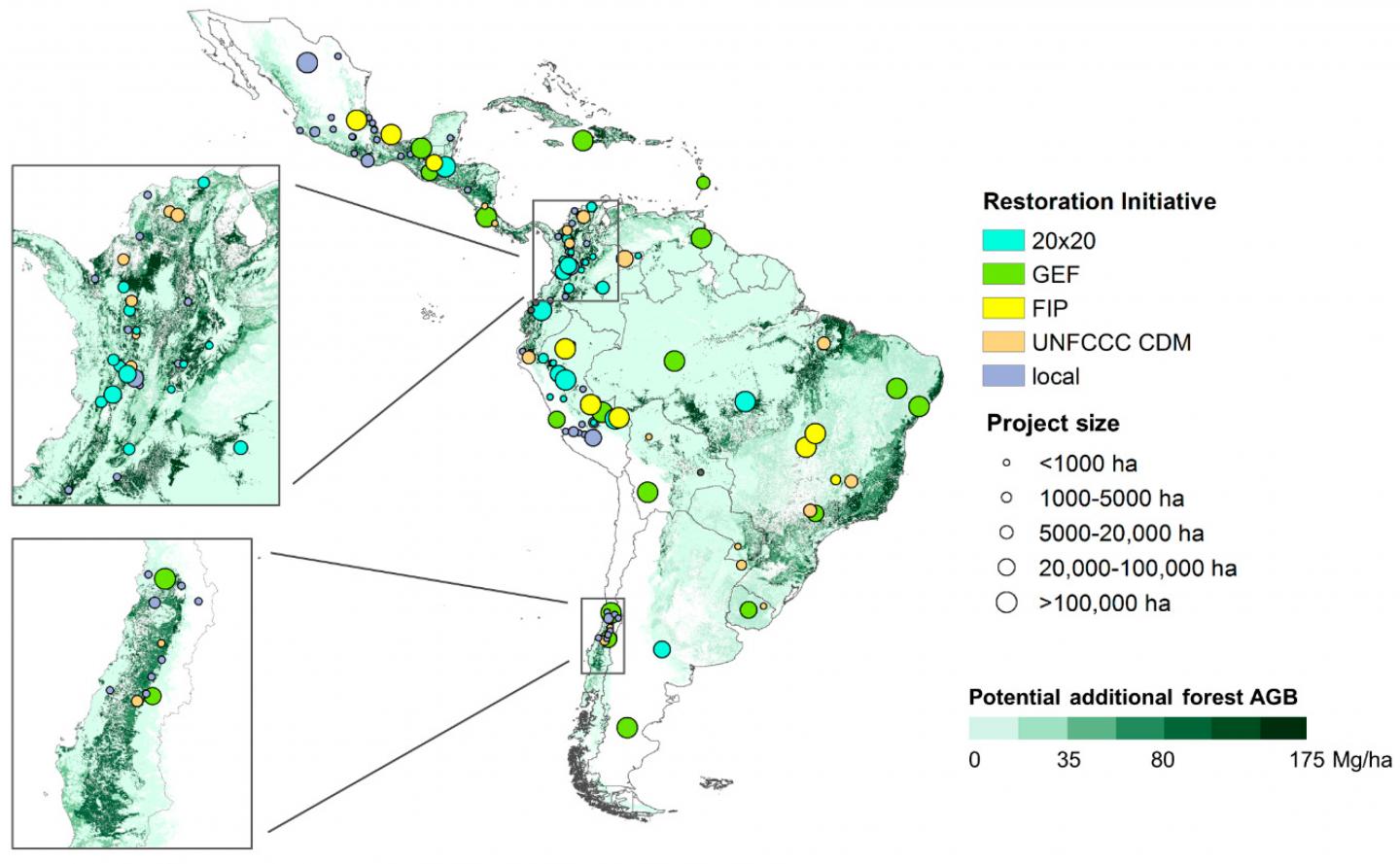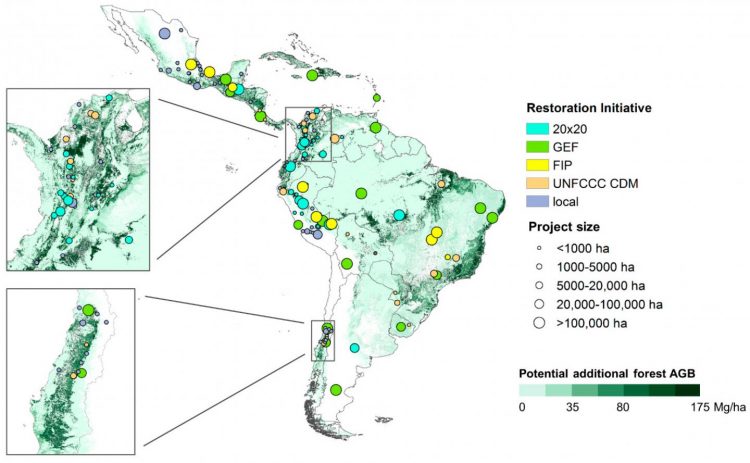Deforestation and Amazon fires grab headlines but 150-plus restoration projects in Latin America show where considerable advances at tackling climate change are happening

Credit: Erika Romijn et al.
Land restoration in Latin America and the Caribbean is picking up pace and scaling up projects will help the region meet its pledges under the Bonn Challenge, which aims to restore 350 million hectares of degraded and deforested land worldwide by 2030. A new study led by the International Center for Tropical Agriculture (CIAT) and Wageningen University supplies a first map of restoration projects in Latin America and shows their potential to mitigate climate change through restoring forests.
Researchers took stock of the location, goals and activities of 154 projects in Latin America and the Caribbean, starting a database to guide practitioners in scaling up restoration. They mapped projects under five initiatives working towards the Bonn Challenge goals – the 20×20 Initiative, the Global Environment Facility, the Clean Development Mechanism (CDM), the Forest Investment Program (FIP) and independent local projects – in tandem with mapping the potential biomass increase that forest restoration could achieve across the region’s various ecosystems.
“We’re asking a lot from the land, to produce food for another couple of billion people. We also don’t want to lose more forest,” said co-author Louis Verchot, a researcher at CIAT and a leading contributor to the Intergovernmental Panel on Climate Change (IPCC)’s recent Climate Change and Land report. “We need to make more out of the land that we have. The IPCC 1.5 °C report made clear how fast we need to take carbon out of the atmosphere. To do that, you have to do something about land emissions.”
In Latin America many of the ongoing or planned projects are in regions where there is high potential for increased biomass, such as the tropical and subtropical forest ecosystems on the edges of the Amazon Basin, Southeast Brazil and Central America. While all projects can provide more forest biomass for carbon sequestration, results show that CDM, FIP and local projects have the biggest capacity to do so. Local level projects also focused on areas with high carbon sequestration potential, and CDM projects focused on forestry plantation efforts. Projects associated with the initiative 20×20 pursued a diverse set of goals in a wider range of landscapes and was less focused on carbon sequestration.
While all projects mainly aim to increase vegetation cover, recover biodiversity and ecosystem services, restoration takes many faces across Latin America, which impacts how much carbon a restored area will be able to capture, the study shows. Natural regeneration is the most popular choice for restoring vegetation, along with assisted regeneration and mixed plantations. GEF, FIP and local restoration projects preferred this low-cost, high-carbon sink approach, point out the researchers. These “may contribute widely to climate change mitigation,” the study says.
“Natural regeneration is a cost-effective restoration method,” said Verchot, who is part of the Agroecosystems and Sustainable Landscapes research team at CIAT. “You don’t have to invest in seedling production and plantations. On the other hand, you get what you get. In degraded lands you get pioneer species, it might take decades to get back the pre-disturbed mix of species.”
The study is the latest on the topic by Verchot and colleagues, including a paper published earlier this year that created a typology of land restoration in Latin America and the Caribbean. The study categorized three main restoration types, with the main defining variables being project area under restoration, amount of funding received, source of funding and monitoring efforts.
Drylands out of the restoration spotlight
Only 25 percent of restoration projects surveyed in Latin America focus on degraded drylands, the research shows, despite their exposure to desertification, loss of biodiversity, food insecurity and climate change. Visualizing the region’s potential for more carbon-storing vegetation can help project developers spot which degraded drylands are in need of restoration. Donors and funding mechanisms that finance the projects have a big say on the goals and activities, the study says.
“A diversity of projects and initiatives will contribute towards achieving the aims of the Bonn Challenge and restore large amounts of degraded land,” conclude the authors. But to be successful, we need to tackle the problem at its source. Large-scale restoration projects first need to understand what drives deforestation and forest degradation, as well as the ecological and social climate in which they happen, so that we better manage our lands and avoid the need to restore them in the future.
###
Funding and acknowledgements
This research was funded by USAID support to the CGIAR through grant number AID-BFS-IO-17-00005. The authors gratefully acknowledge the support of the USAID Office of Global Climate Change, the CGIAR Research Program on Forests, Trees and Agroforestry, the CGIAR Research Program on Climate Change, Agriculture and Food Security (CCAFS), and CIFOR’s Global Comparative Study on REDD+. We also thank CIFOR, ICRAF, Bioversity International, SERFOR, WRI and CIAT for sharing their project databases.
Media Contact
Sean Mattson
[email protected]
Related Journal Article
http://dx.





